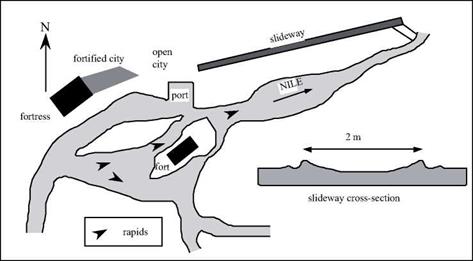More to the south: hydraulic works at the second cataract
The pharaohs of the middle Empire tried to develop fluvial commerce with Nubia while at the same time protecting themselves from Nubia. Sesostris III extends the border of Egypt up to Semna, beyond the second cataract. A stela contains the following text: “Southern border established in year 8 of his majesty the king Khakaoure (Sesostris III), so as to prevent any Nubian from crossing it, by land or boat, neither any Nubian herds; except Nubians who would come to do commerce in Iken (Mirgissa), but not to the point that any Nubian boat travels to the north beyond Heh (at the northern outlet of the pass of Semna), 17
ever.
The pass at Semna is fortified to enforce this proclamation, and to tightly control traffic on the Nile. The water surface is artificially raised and the Nile flumes are blocked, so that boats can pass only through the narrow passage between the two forts constructed on each bank.
At the second cataract, the site of Mirgissa is also fortified. A slideway is built for hauling boats around the natural obstacle formed by the cataract rapids. Boats enter this slideway from a harbor built in the calm upstream waters (Figure 3.5). The slideway, likely from the reign of Sesostris III (around 1870 BC)[102] [103] has a useful width of about two meters, and is sloped to facilitate the hauling. It is lined with wood and silt kept damp.
|
Figure 3.5 Hydraulic works at Mirgissa, at the second cataract (schematic reconstitution from Goyon, 1986; Vercoutter, 1991). |







Leave a reply